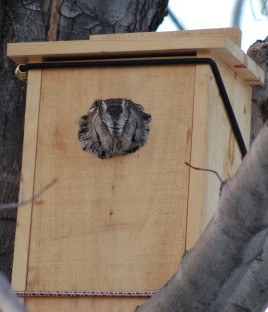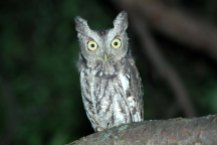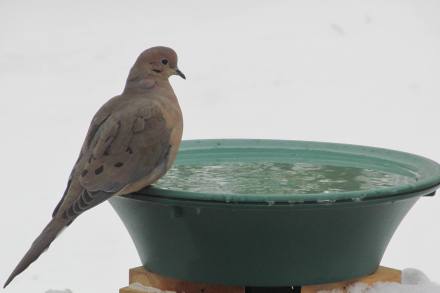Winter conditions still dominate the Buffalo-Niagara Region. However, even with vernal equinox nearly a month away, early signs of spring are already evident. The best indicators of the advancing spring are provided by birds and mammals. Some great horned owls are already incubating eggs and most others will be on-nest by early March. Other raptors, including bald eagles, peregrine falcons, and red-tailed hawks have started to prepare nests and most will lay eggs by mid-March. Barred owls and eastern screech owls are increasingly vocal at this time and will soon start to establish nesting territories.
Flocks of male red-winged blackbirds are just beginning to reach our Region. These northbound migrants are returning to summer breeding areas where they will rapidly establish nesting territories. Their arrival suggests that other early migrant species such as killdeer, American robin, eastern bluebird, eastern meadowlark, common grackle, and brown-headed cowbird will soon follow. In response to longer daylength and its effects on bird hormones, several species of songbirds are now singing occasionally. Thus, the 2019 songbird breeding season has begun (albeit the very early stages). Early singing species include mourning dove, black-capped chickadee, tufted titmouse, white-breasted nuthatch, Carolina wren, blue jay, American crow, northern cardinal, and house finch. Also included are downy, hairy, red-bellied, and pileated woodpeckers that use song as well as drumming as an advertising display. Typical winter-resident songbirds such as the dark-eyed junco and American tree sparrow will remain in our Region several more weeks but have also started singing, well before migrating north to their nesting grounds.
Early signs of spring are also offered by wild mammals in the Buffalo-Niagara Region. Gray squirrel activity has been heightened recently by the onset of their breeding season. A few eastern chipmunks have emerged from winter dens and are actively feeding and breeding. Coyotes, red fox, and gray fox are noticeably more active as they have begun courtship and mating. The mating seasons for Virginia opossum, raccoon, striped skunk, and mink start in early February and extend into March. Sadly, roadkill is often the best evidence of increased activity by these species.
Below are highlights of what you can expect to find outdoors in the Buffalo-Niagara Region this week. Those in bold/italics are new or substantially revised highlights to watch for this week. Check out the list of 300 publicly accessible sites at https://bnnatureblog.com/nature-sites/site-lists/alphabetical-list/ to find areas to explore in your neighborhood and throughout the Buffalo-Niagara Region.
Average Sunrise/Sunset (Day Length):
- 7:03 AM/5:55 PM EST (10 Hours, 52 Minutes)
- 1 Hour, 51 minutes of daylight longer than at Winter Solstice
Typical Weather:
- Normal High Temperature: 34.7° F Normal Low Temperature: 20.1° F
Lake, Pond, Stream & Wetland Conditions:
- The Lake Erie water temperature off Buffalo remained at 32°F and the Lake Ontario water temperature off Greece (Monroe County) remained at 35°F as of February 25, 2019.
- Lake Erie is now mostly ice-covered while Lake Ontario is mostly ice-free, other than shore ice.
- Inland ponds, wetlands, and vernal pools are mostly ice-covered.
- Many streams are now partly or mostly ice-free following the recent warmup.
Fungi:
- With the onset of winter, most fungal fruiting bodies (e.g., mushrooms, bracket fungi) have been extinguished. The fungal “roots” (mycelium network) will survive the winter and produce new fruiting bodies during the appropriate season next year. Interestingly, fruiting bodies of some species of fungi (e.g., oyster mushrooms) remain viable during the winter and may disseminate spores during warm periods or in early spring.
Ferns and Grasses/Sedges/Rushes:
- Freezing temperatures during late autumn killed remnant grass, sedge, and rush stems. The roots of these perennial plants will survive and sprout next spring.
Wildflowers:
- Wildflower stems died back following late fall freezing temperatures. Roots and rhizomes of perennial wildflowers will survive and sprout next spring. Seeds of annual wildflowers will do the same.
Trees and Shrubs:
- Some American beech trees will hold their dead leaves over most of the winter.
- A few native shrubs and vines continue to provide fruit (soft mast) that is an important winter food source for a variety of birds and mammals: cranberry viburnum, staghorn sumac, and swamp rose.
- In addition, one non-native species, multiflora rose, provides fruit consumed by wildlife.
Insects & Other Invertebrates:
- Freezing temperatures during late autumn killed most adult insects and other invertebrates that have not migrated or entered hibernation. The vast majority of insect species in our Region over-winter as eggs or larvae/nymphs/pupae, although some species over-winter as adults.
- On warm and sunny days in late winter, watch for “snow fleas” (springtails), especially at the bases of tree trunks in streamside areas. They emerge in large numbers and may appear like a sprinkling of pepper on the surface of snow. They apparently do not feed or mate but instead seem to wander somewhat aimlessly before returning below the surface at night.
- Also watch for small winter stoneflies, winter craneflies, winter scorpion flies, and winter gnats.
Fish:
- Burbot (AKA freshwater cod) spawn throughout February and early March in the Great Lakes, forming writhing balls of a dozen or more intertwined fish.
- During brief warm periods throughout winter, fresh steelhead from Lakes Erie and Ontario migrate into tributary streams (including Niagara River) in preparation for spring spawning. Steelhead are an anadromous form of rainbow trout that spawn in streams but live most of their lives in Lakes Erie and Ontario. All forms of rainbow trout are native to Pacific coast watersheds.
- Some brown trout that spawned in Great Lakes tributaries and the Lower Niagara River in autumn remain in those areas through winter. Brown trout were introduced into our Region from Europe.
Amphibians & Reptiles:
- With the onset of winter weather, essentially all amphibians and reptiles are now hibernating (technically considered brumation).
Water & Shore Birds, Gulls & Terns:
- The annual buildup of “sea ducks” and similar waterbirds that over-winter in the Great Lakes and Niagara River is near its peak with impressive numbers of greater scaup, lesser scaup, canvasback, redhead, common goldeneye, bufflehead, white-winged scoter, surf scoter, black scoter, long-tailed duck, common merganser, and red-breasted merganser.
- Watch for winter resident tundra swans congregating in open waters along the upper Niagara River (especially off Beaver Island, Buckhorn, and Niagara Falls State Parks).
- This continues to be a good time to look for purple sandpipers feeding in rocky habitats above Niagara Falls.
Birds of Prey:
- Bald eagles can still be found along the upper and lower Niagara River where good numbers are over-wintering.
- Bald eagles typically begin performing aerial courtship displays at about this time. Some of the breeding pairs in our Region will start nesting over the next week or two, and many will be on-nest by mid-March.
- Some red-tailed hawks are now paired up and have initiated nest building. Many will be incubating eggs by mid-March.
- Winter resident raptors will continue to occur in the region, especially in areas with extensive open grassland habitat, including northern harriers, rough-legged hawks, snowy owls, short-eared owls, and long-eared owls.
- Snowy owls are frequently found along Great Lakes shorelines, such as the Buffalo waterfront, where they feed on ducks and other waterbirds.
- Some great horned owls are already on-nest, incubating eggs, and most others will be nesting by early March. Horned owls do not build their own nests but instead usurp existing red-tailed hawk nests and tree cavities.
- Barred owls and eastern screech owls will be increasingly vocal this week and over the next several weeks as they establish nesting territories.
Upland Game Birds:
- Watch for wild turkey flocks in farm fields, along forest edges, and near bird feeders.
Songbirds:
- Watch bird feeders for the following songbird species that are part of this year’s “winter finch” irruption: purple finch, red crossbill, white-winged crossbill, common redpoll, hoary redpoll, pine siskin, evening grosbeak, and red-breasted nuthatch. Nyjer (AKA thistle) and black oil sunflower are the best seeds for attracting these species.
- Bird feeders are also excellent locations to watch for arrivals of more typical migrant and over-wintering feeder birds such as dark-eyed junco, white-throated sparrow, song sparrow, and American tree sparrow. Place seed such as white millet in ground feeders or directly on the ground to attract many of these migrants.
- Bird feeders will continue to be active with year-round resident birds such as mourning dove, downy woodpecker, hairy woodpecker, red-bellied woodpecker, black-capped chickadee, tufted titmouse, white-breasted nuthatch, blue jay, northern cardinal, house finch, and American goldfinch.
- Good tips for feeding birds are available from the Cornell Lab of Ornithology, online at http://www.birds.cornell.edu/AllAboutBirds/notes/BirdNote01_WinterFeeding.pdf
- If you don’t have a feeder of your own, consider visiting a local nature center (see the 2nd to last column in the tables of nature viewing sites found under the “B-N Region & Sites” tab on this web page).
- The northern shrike, a predatory passerine that breeds in Canada and Alaska, will continue to occur in the Region. Watch for them on prominent perches overlooking open and brushy habitats.
- Small to medium sized flocks of American robins and family groups of eastern bluebirds may be encountered in our Region at this time. Most are birds that over-wintered here since northbound migrant flocks are still mostly to our south at this time.
- Flocks of male red-winged blackbirds are just starting to reach our Region. Some of these northbound migrants are returning to summer breeding sites in our Region where they will rapidly establish nesting territories.
- Small flocks of horned larks and Lapland longspurs and large flocks of snow buntings can be found in open farmland and other tundra-like habitats by snow buntings.
- Several species of songbirds are now singing occasionally, initiating the 2019 songbird breeding season (albeit the very early stages). These species include mourning dove, black-capped chickadee, tufted titmouse, white-breasted nuthatch, Carolina wren, blue jay, American crow, northern cardinal, dark-eyed junco, and house finch. Also included are downy, hairy, red-bellied, and pileated woodpeckers that use drumming as well as vocalizations.
- To stay abreast of bird sightings in the region, consult eBird, Genesee Birds, and Dial-a-Bird (see the “Resources” tab on this web page for more details).
Mammals:
- Resident species of cave bats (big brown, little brown, and eastern pipistrelle [tri-colored] bats), woodchucks, and meadow & woodland jumping mice continue to hibernate. These species are true hibernators.
- False hibernators such as the raccoon and striped skunk are mostly dormant, other than occasional feeding and breeding forays during relatively warm weather. In contrast, Virginia opossums stay active all winter other than brief denning during particularly cold weather.
- Most eastern chipmunks remain in a state of torpor. In this condition, which is not a true form of hibernation, chipmunks sleep but arouse frequently to feed on hoarded food. They may forage aboveground during mild weather.
- Gray squirrels and southern flying squirrels continue to actively forage for cached acorns and other available food, other than during extremely cold periods. Similarly, red squirrels feed from middens of pine and spruce cones.
- Watch for increased activity by gray squirrels. They mate in February and early March.
- Watch bird feeders after dark for nocturnal visits by southern flying squirrels.
- A few eastern chipmunks have emerged from winter torpor and are actively feeding and looking for mates.
- Some white-footed mice and deer mice spend the winter in nests they built in woodpecker holes, bird houses, and squirrel leaf-nests. Some rehab old bird nests by adding a roof and insulation.
- Beavers continue to feed on cut branches they cached in shallow water near their lodges during the fall, and muskrats do the same with herbaceous vegetation cached near their lodges.
- The mating season for beavers is January and February.
- The mating seasons for Virginia opossum, raccoon, and mink start in early February and extend into March. Sadly, roadkill is often the best evidence of this increased activity.
- Skunks are noticeably active in mid to late February as their breeding season begins. Watch for tracks of wandering males searching for females. Or just take a sniff outdoors first thing in the morning.
- Watch for increased activity by coyotes, red fox, and gray fox as they are now courting and mating.
- Ermine (AKA short-tailed weasel) have molted from brown to white pelage for winter months.
- Black bears, an uncommon species in the Buffalo-Niagara Region but increasingly common to our south, are in carnivorous lethargy. In this state, which is not a true form of hibernation, a bear’s heart rate is significantly lowered but body temperature falls only about 10°F (substantially smaller drop than for true hibernators).
- Black bear cubs are typically born in January or early February while sows are in a state of carnivorous lethargy.
- White-tailed deer continue to travel in herds. Finding food will continue to be difficult until the growing season begins.
Be sure to find an opportunity to get outside this week to discover signs of the season.
Chuck Rosenburg















Reblogged this on Wolf's Birding and Bonsai Blog.
LikeLike